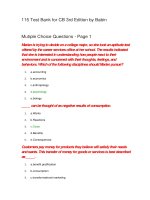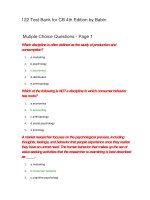Marketing chapter 5a understanding consumer behavior
Bạn đang xem bản rút gọn của tài liệu. Xem và tải ngay bản đầy đủ của tài liệu tại đây (2.05 MB, 139 trang )
McGraw-Hill/Irwin
Copyright © 2009 by The McGraw-Hill Companies, Inc. All Rights
LEARNING OBJECTIVES (LO)
AFTER READING CHAPTER 5, YOU SHOULD BE ABLE TO:
LO1
LO2
Describe the stages in the consumer
purchase decision process.
Distinguish among three variations of
the consumer purchase decision
process: routine, limited, and extended
problem solving.
5-2
LEARNING OBJECTIVES (LO)
AFTER READING CHAPTER 5, YOU SHOULD BE ABLE TO:
LO3
Identify major psychological influences
on consumer behavior.
LO4
Identify the major sociocultural
influences on consumer behavior.
5-3
LO1
PURCHASE DECISION PROCESS
PROBLEM RECOGNITION
Consumer Behavior
Purchase
Decision Process
5-4
CONSUMER PURCHASE
DECISION PROCESS
• Consumer Behavior
– Actions a person takes in purchasing
and using products and services –
including the mental and social
processes that come before and after
these actions
Slide 5-6
CONSUMER PURCHASE
DECISION PROCESS
• Purchase Decision Process
– Stages a buyer passes through in
making choices about which products
and services to buy
– The five stages are:
1) Problem recognition
2) Information search
3) Alternative evaluation
4) Purchase decision
5) Post-purchase behavior
Slide 5-6
FIGURE 5-1 The purchase decision process
consists of five stages
5-7
LO1
PURCHASE DECISION PROCESS
INFORMATION SEARCH
Internal Search
External Search
• Personal Sources
• Public Sources
• Market-Dominated Sources
5-8
CONSUMER PURCHASE
DECISION PROCESS
1. Problem Recognition: Perceiving a
Need
– Perceives a difference between a
person’s ideal and actual situations
big enough to trigger a decision
– Advertisements or salespeople can
activate a consumer’s decisionmaking process by showing the
shortcomings of competing or
currently owned products
Slide 5-6
CONSUMER PURCHASE
DECISION PROCESS
2. Information Search: Seeking Value
– Internal Search – scanning one’s
memory for previous experiences with
products or brands
– Often sufficient for frequently
purchased products
Slide 5-6
CONSUMER PURCHASE
DECISION PROCESS
2. Information Search: Seeking Value
– External Search – necessary when
past experience or knowledge is
insufficient, risk of making a bad
decision is high , and cost of gathering
information is low
Slide 5-6
CONSUMER PURCHASE
DECISION PROCESS
2. Information Search: Seeking Value
– External Search – primary sources
of external information:
a) Personal sources – friends and
relatives whom consumer trusts
b) Public sources – includes various
product-rating organizations like
Consumer Reports, government
agencies, or consumer-oriented TV
programs
Slide 5-6
CONSUMER PURCHASE
DECISION PROCESS
2. Information Search: Seeking Value,
cont.
– External Search – primary sources
of external information:
c) Marketer-dominated sources –
information from sellers that include
advertising, company websites,
salespeople and point-of-purchase
displays in stores
Slide 5-6
CONSUMER PURCHASE
DECISION PROCESS
3. Alternative Evaluation: Assessing
Value
– The information stage clarifies the
problem for consumers by:
– Suggesting criteria, or points to
consider, for the purchase
– Providing brand names that might
meet the criteria
– Developing consumer value
perceptions
Slide 5-6
LO1
PURCHASE DECISION PROCESS
ALTERNATIVE EVALUATION
Evaluative Criteria
Consideration Set
5-15
CONSUMER PURCHASE
DECISION PROCESS
3. Alternative Evaluation: Assessing
Value
– Consumer’s evaluative criteria
represent both the objective attributes
of a brand and the subjective ones
used to compare different products
and brands (often mentioned in
advertisements)
Slide 5-6
CONSUMER PURCHASE
DECISION PROCESS
3. Alternative Evaluation: Assessing
Value, cont.
– Consumers often have several criteria
for evaluating brands and these
criteria establish the consideration set
– the group of brands that a consumer
would consider acceptable from
among all brands in the product class
Slide 5-6
FIGURE 5-2 Consumer Reports’ evaluation
of flash-memory MP3 players (abridged)
5-18
FIGURE 5-A What new car buyers consider
most important in deciding what new car to
buy
Slide 5-11
LO1
PURCHASE DECISION PROCESS
PURCHASE DECISION
Decide from Whom to Buy
Decide When to Buy
5-20
CONSUMER PURCHASE
DECISION PROCESS
4. Purchase Decision: Buying Value
–
–
–
Having examined the alternatives, two
choices remain:
From whom to buy, which is determined
by the seller’s terms of sales, past
purchase experience return policy, etc.
When to buy, which is determined by
whether the product is on sale,
coupon/rebate, store’s atmosphere,
shopping experience, salesperson
persuasiveness, time pressure,
financial terms, etc.
Slide 5-6
CONSUMER PURCHASE
DECISION PROCESS
4. Purchase Decision: Buying Value
– The internet adds technological
dimension by allowing
consumers to:
• Gather information,
• Evaluate alternatives, and
• Make buying decisions
Slide 5-6
CONSUMER PURCHASE
DECISION PROCESS
5. Post Purchase Behavior: Value in
Consumption or Use
– After buying a product, the consumer
compares it expectations and is either
satisfied or dissatisfied.
Slide 5-6
Consumer Purchase Decision
Why is post purchase behavior important?
Slide 5-13
CONSUMER PURCHASE
DECISION PROCESS
5. Post Purchase Behavior, cont.
•
Customer’s satisfaction or dissatisfaction
with the consumption or use experience
affects their value perceptions and
repeated purchase behavior
– Satisfied buyers tell three other people
about their experience, while
dissatisfied buyers tell nine people
– Satisfied buyers tend to buy from the
same seller each time a purchase
decision arises, creating a huge
financial impact
Slide 5-6









